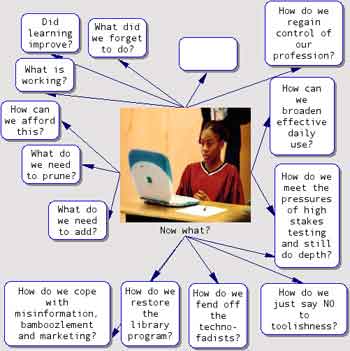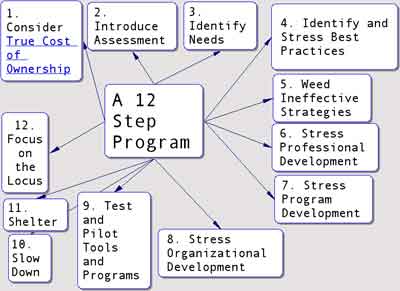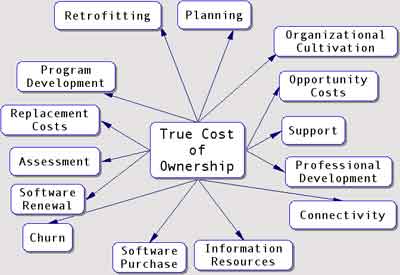|
|
|||||
|
|
| Vol 12|No 11|Summer|2003 | |
|
Please feel free to e-mail this article to a friend, a principal, a parent, a colleague, a teacher librarian, a college professor, a poet, a magician, a vendor, an artist, a juggler, a student, a news reporter or anyone you think might enjoy it. Other transmissions and duplications not permitted. (See copyright statement below).
Time for Reflection Ten years after introducing the Internet to classrooms, many districts and schools are looking at ways to win a return on their sizable investments in new technologies. The inflated promises of vendors and technology cheerleaders rarely materialized and the impact on student performance has been weak or unsubstantiated at best. In many classrooms, new equipment sees sporadic or frivolous use. Powerpointlessness is rampant. Questions abound. Why did we network? How might these technologies help us with NCLB?
Ten years into this innovation, what essential questions should we be asking in order to win better results and create a new, stronger generation of classroom practices? It is this questioning process that holds the greatest promise for change and improvement. Having discovered that the mere possession of laptops and computers works few miracles, teachers and school leaders must now play "catch up" and fill in the blanks left by promoters and salespeople who pushed networking, penetration and possession as silver bullets. Despite the lack of respect paid these days to pedagogy by highly placed education officials, it is effective teaching strategies and lesson designs that are most likely to win gains in learning. If you click on the diagram below, you can view a larger version. Birds of a feather?
Can we resist the temptation to join the flock? We rushed to network without asking tough questions, without piloting programs and without heeding decades of research on winning change in schools. In too many districts, it was a case of the blind leading the blind. Can we now create a flight plan that is just right for our school? For our students? The power of our plan will depend upon the degree to which we can customize our efforts to match local conditions and special challenges. Packages rarely work when imported from the outside without such adjustments. Twelve Strategies to Maximize ReturnClick on a strategy in the cluster diagram below to read how it might benefit your school.
We are more likely to win major improvement when we anticipate and fund all of the major elements of an innovation before launch. Failure to recognize and fund such elements may severely limit results and cause actual failure. Many schools neglected to fund professional, organizational and program development when they added computer networks. They also starved technical support while underestimating the need for periodic upgrading and replacement of equipment in addition to the development of information resources available on the network. Success depends upon recognizing the "True Cost of Ownership." Many business models of this concept - often called "Total Cost of Ownership" - do not include important factors that are basic to successful change in schools. For a thorough review of TCO, read the March, 2003 issue of FNO at http://fno.org/mar03/truecost.html. Beware of TCO models that offer incomplete lists slanted toward business and accounting issues alone. Because program assessment is too rarely conducted as schools introduce new technologies, it is difficult to steer programs forward intelligently by making adjustments and improvements based on data about what is working or not working. A lack of assessment data during the past decade did allow many districts to enjoy the doubtful benefits of denial - the game of the three monkeys who see no evil, hear no evil and speak no evil - but assessment is rapidly becoming a requirement for those who wish to receive NCLB funding. For an example of how assessment can benefit schools implementing programs with new technologies, read "Assessing the Impact of Laptops in Maine" in the June 2003 issue of FNO at http://fno.org/jun03/maine.html.
In the 1990s, some districts adopted thick technology plans laying out a course of action. Several years later that thick plan may remain unchanged - a set of strategies, actions and purchasing decisions that may have made sense when written but may no longer describe current conditions. To make headway during this decade, each school must take stock of where it is along the journey, identifying signs of progress as well as pockets of resistance or frustration. Any revised plan of action must address the particulars rather than just the generalities, as we have learned that no plan fits all. "Different strokes for different strokes!" becomes the rallying cry for this next generation of educational change. This strategy is closely related to the previous one, as needs assessment thrives on the collection of survey data and other information to define what is missing and what requires attention. 4. Identify and Stress Best Practices
In recent years we have paid the price of willy-nilly, whatever, "technology for the sake of technology" practice - a kind of naive endorsement of all things technological as if laptops and desktops automatically produced quality thought or as if the Internet always offered reliable information. In part, because the challenge of integrating these tools into daily use proved more daunting than promised, there was too little discernment. "Just use it!" After a decade of rampant experimentation, we should be able to focus on those strategies most likely to improve student performance. One example might be "Writing the Right Way" in the June 2003 issue of FNO at http://fno.org/jun03/writing.html. Robust local assessment of the type mentioned above assists with this task of identifying best practice, especially when assessment instruments are tied to indicators of learning related to state standards. 5. Weed Ineffective Strategies
Much that passes as technology integration these days may represent a backward slide as students labor for hours over fancy slide transitions and special effects rather than more robust thinking challenges tied to state standards. New information technologies can support a kind of cut-and-paste mentality that does not involve the analysis, interpretation, inference, synthesis and evaluation we should require. Do we have evidence that our students can handle mathematical concepts and problems with more savvy and skill thanks to the time we have devoted to various technology activities? Have we even bothered to gather data or assess the impact of these ventures? If we witness students employing new technologies to research issues in history and science, do we have a basis for claiming that the quality of their thinking has advanced to levels superior to those witnessed previously? Many teachers complain that they have too little time to make it through the heavy load of content dictated by state standards. With instructional time being scarce and precious, it makes sense to limit activities employing new technologies to those that are demonstrably worthwhile. Teachers should be excused from launching classroom activities that are tangential, inconsequential and ineffective. They should be encouraged to prune such activities from their repertoires. 6. Stress Professional Development
While it is now very late in the process for some districts to address adult learning issues, robust professional development is the foundation of effective programs. And this is not so much a matter of software training as curriculum rich learning. Examples are described in detail in this month's FNO - "Stories of Adult Learning" at http://fno.org/sum03/adult.html. It’s a jungle out there!
Many teachers will find the Internet too poorly structured to support efficient learning unless we invest in lesson and unit development that meets their desire for order and practicality. Teachers seek structured lessons and scaffolding to deliver efficiency, quality and standards-based learning. They also require quality digital content, as the process of digitizing materials has been slower than expected. Major institutions such as the Library of Congress have a long way to go converting print resources to digital. Serious gaps remain in current digital offerings. For more information about lesson design, note "The Slam Dunk Digital Lesson" in the September 2002 issue of FNO at http://fno.org/sept02/slamdunk.html. For more information about scaffolding, note "Scaffolding for Success" in the December, 1999 issue of FNO at http://fno.org/dec99/scaffold.html. 8. Stress Organizational Development Schools must foster collaborative cultures to encourage sustained, system-wide innovation. The work of Bruce Joyce, Michael Fullan, Terence Deal and Ann Lieberman contrasts with the school change strategies of the past technological decade and suggests that change must be built from the classroom level up.
We must reject the facile calls for unhealthy competition, blame and punitive accountability that are so popular in Washington these days, as if threats ever led to higher performance in schools. Many of the most productive adult learning strategies call for communities of practice that require cooperative norms. No more lunging on mere faith. We must revert to the time-honored tradition of testing and modifying new programs before adopting them on a wide basis. This approach was suddenly (and foolishly) laid aside when the Internet first appeared. Time to dust it off and bring such testing back into routine practice. Limited risk and maximal opportunity. No program before it’s time. This is not a race to be first. We should emphasize quality over speed and quantity.
Churn is not healthy or productive change. Instead, we should be emphasizing values such as the following:
For more information about "Pacing Change" see the November/December issue of FNO at http://fno.org/nov00/pacing.html. Turbulence can undermine the effectiveness of a program. Trendy new fashions and bandwagons can divert teachers from their real business.
Teachers nurture growth and learning when they can count on reasonable levels of support and predictability. Pushed to the wall by stress and churn, they plummet to what Maslow called the survival stage. At this stage, they are consumed by what Fullan identified as the "daily press" - just getting the basic job done. Thrown off balance, they are more apt to cling to routines and limit experimentation. Smart leaders protect schools and teachers from too much change too fast. They shelter the school from "The New New Thing" - see the article in the April 2000 issue of FNO at http://fno.org/apr2000/newnew.html. Shelter from the storm. Shelter from the fad. Avoid techno-saturation. Put new tools where they will be used the most.
Instead of saturating schools, we should act strategically. It is time for precision-guided programs. We conserve energy and resources. We put equipment where it will do the most good. We dismiss the “Any Time - Any Where” strategy as marketing hype. We shrug off the pressures for one-on-one computing and just-in-case computing. We embrace just-in-time computing. We move equipment. We share. We bring it into a room when we need it. We move it out when we do not need it. We look more carefully at our school's culture and readiness. Instead of spreading computers thinly across a building so that all teachers have the same number of computers (and none have critical mass), why not build the program around the most enthusiastic and competent teachers and put the resources where they will be used? For more information on this strategy, see "Focus on the Locus" in the May, 2003 issue of FNO at http://fno.org/may03/focus.html. |
||||||
|
Back to Summer Cover
Credits: The photographs were shot by Jamie McKenzie and are copyrighted.
Copyright Policy: Materials published in From Now On may be duplicated in hard copy format if unchanged in format and content for educational, nonprofit school district and university use only and may also be sent from person to person by e-mail. This copyright statement must be included. All other uses, transmissions and duplications are prohibited unless permission is granted expressly. Showing these pages remotely through frames is not permitted.
FNO is applying for formal copyright registration for articles. Unauthorized abridgements are illegal.
|
 From Now On
From Now On







